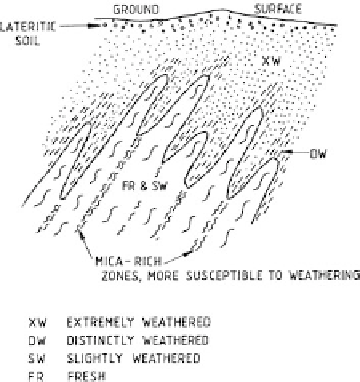Environmental Engineering Reference
In-Depth Information
Figure 3.13.
Weathered profile developed on schistose rock with steeply dipping foliation.
3.4.3
Suitability of schistose rocks for use as filter materials, concrete aggregates and
pavement materials
Schistose rocks are generally unsuitable for any of these purposes due to the very flaky
shapes of the crushed materials and inadequate strengths of the particles. Kammer and
Carlson (1941) describe the unsuccessful use of phyllite as aggregate for concrete in a hydro-
electric plant. Silicates in the phyllite reacted with alkalis in the cement to cause expansion
and disruption of the concrete. The strongest, most siliceous schists have been used suc-
cessfully in base courses of pavements, where more suitable materials have not been available.
3.4.4
Suitability of schistose rocks for use as rockfill
Despite their tendency to produce very platy block shapes, schistose rocks have been used
successfully as rockfill on several dams up to 80 m high. At Kanmantoo Mine in South
Australia a 28 m high rockfill dam with a thin sloping earth core was built in 1971 for the
storage of tailings and water for use at the mine (Stapledon et al., 1978). The rockfill was
mainly very weak quartz-biotite schist, the waste rock from the mine. It was placed in
0.6-0.9 m thick layers and compacted dry with a Caterpillar D8 tractor and by traffick-
ing by the 50-tonne dump trucks. Post-construction crest settlements 5.5 years after com-
pletion ranged from 0.3% to 0.7% of the embankment height.
The successful use of schist as rockfill at Kangaroo Creek Dam has been described by
Good (1976) and Trudinger (1973). Trudinger describes in some detail the construction
procedures, the behaviour of the rock and the fill densities obtained. The concrete faced
dam as built initially was 60 m high. Zone 3, which contained about 300,000 m
3
of the
443,000 m
3
total rock in the embankment, was built mainly of weak to medium strong,
slightly weathered schist compacted in 1 m layers. The maximum specified block size was
1 m, but many blocks were longer than this due to the very platy shapes obtained during
quarrying (
Figure 3.14
). Because the schist suffered a large strength loss on saturation
(
Figure 3.12
) the rock was heavily watered during placement. During compaction by 4
passes of a 10-tonne vibrating roller, the uppermost 50-300 mm of most layers were
crushed into a gravelly sandy silt (
Figure 3.15
)
. These layers formed thin, lower perme-
ability barriers but were readily penetrated by the basal rocks of the next layer and hence
they did not form weak or compressible zones in the dam.


